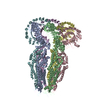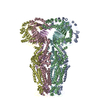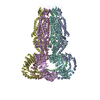[English] 日本語
 Yorodumi
Yorodumi- PDB-5zsu: Structure of the human homo-hexameric LRRC8A channel at 4.25 Angstroms -
+ Open data
Open data
- Basic information
Basic information
| Entry | Database: PDB / ID: 5zsu | ||||||
|---|---|---|---|---|---|---|---|
| Title | Structure of the human homo-hexameric LRRC8A channel at 4.25 Angstroms | ||||||
 Components Components | Volume-regulated anion channel subunit LRRC8A | ||||||
 Keywords Keywords | MEMBRANE PROTEIN | ||||||
| Function / homology |  Function and homology information Function and homology informationMiscellaneous transport and binding events / pre-B cell differentiation / volume-sensitive anion channel activity / taurine transmembrane transport / aspartate transmembrane transport / cyclic-GMP-AMP transmembrane transporter activity / cyclic-GMP-AMP transmembrane import across plasma membrane / monoatomic anion transmembrane transport / cell volume homeostasis / monoatomic anion transport ...Miscellaneous transport and binding events / pre-B cell differentiation / volume-sensitive anion channel activity / taurine transmembrane transport / aspartate transmembrane transport / cyclic-GMP-AMP transmembrane transporter activity / cyclic-GMP-AMP transmembrane import across plasma membrane / monoatomic anion transmembrane transport / cell volume homeostasis / monoatomic anion transport / protein hexamerization / response to osmotic stress / monoatomic ion channel complex / intracellular glucose homeostasis / positive regulation of myoblast differentiation / chloride transmembrane transport / positive regulation of insulin secretion / spermatogenesis / lysosomal membrane / cell surface / membrane / identical protein binding / plasma membrane / cytoplasm Similarity search - Function | ||||||
| Biological species |  Homo sapiens (human) Homo sapiens (human) | ||||||
| Method | ELECTRON MICROSCOPY / single particle reconstruction / cryo EM / Resolution: 4.25 Å | ||||||
 Authors Authors | Kasuya, G. / Nakane, T. / Yokoyama, T. / Shirouzu, M. / Ishitani, R. / Nureki, O. | ||||||
 Citation Citation |  Journal: Nat Struct Mol Biol / Year: 2018 Journal: Nat Struct Mol Biol / Year: 2018Title: Cryo-EM structures of the human volume-regulated anion channel LRRC8. Authors: Go Kasuya / Takanori Nakane / Takeshi Yokoyama / Yanyan Jia / Masato Inoue / Kengo Watanabe / Ryoki Nakamura / Tomohiro Nishizawa / Tsukasa Kusakizako / Akihisa Tsutsumi / Haruaki Yanagisawa ...Authors: Go Kasuya / Takanori Nakane / Takeshi Yokoyama / Yanyan Jia / Masato Inoue / Kengo Watanabe / Ryoki Nakamura / Tomohiro Nishizawa / Tsukasa Kusakizako / Akihisa Tsutsumi / Haruaki Yanagisawa / Naoshi Dohmae / Motoyuki Hattori / Hidenori Ichijo / Zhiqiang Yan / Masahide Kikkawa / Mikako Shirouzu / Ryuichiro Ishitani / Osamu Nureki /    Abstract: Maintenance of cell volume against osmotic change is crucial for proper cell functions. Leucine-rich repeat-containing 8 proteins are anion-selective channels that extrude anions to decrease the cell ...Maintenance of cell volume against osmotic change is crucial for proper cell functions. Leucine-rich repeat-containing 8 proteins are anion-selective channels that extrude anions to decrease the cell volume on cellular swelling. Here, we present the structure of human leucine-rich repeat-containing 8A, determined by single-particle cryo-electron microscopy. The structure shows a hexameric assembly, and the transmembrane region features a topology similar to gap junction channels. The LRR region, with 15 leucine-rich repeats, forms a long, twisted arc. The channel pore is located along the central axis and constricted on the extracellular side, where highly conserved polar and charged residues at the tip of the extracellular helix contribute to permeability to anions and other osmolytes. Two structural populations were identified, corresponding to compact and relaxed conformations. Comparing the two conformations suggests that the LRR region is flexible and mobile, with rigid-body motions, which might be implicated in structural transitions on pore opening. | ||||||
| History |
|
- Structure visualization
Structure visualization
| Movie |
 Movie viewer Movie viewer |
|---|---|
| Structure viewer | Molecule:  Molmil Molmil Jmol/JSmol Jmol/JSmol |
- Downloads & links
Downloads & links
- Download
Download
| PDBx/mmCIF format |  5zsu.cif.gz 5zsu.cif.gz | 738 KB | Display |  PDBx/mmCIF format PDBx/mmCIF format |
|---|---|---|---|---|
| PDB format |  pdb5zsu.ent.gz pdb5zsu.ent.gz | 633.2 KB | Display |  PDB format PDB format |
| PDBx/mmJSON format |  5zsu.json.gz 5zsu.json.gz | Tree view |  PDBx/mmJSON format PDBx/mmJSON format | |
| Others |  Other downloads Other downloads |
-Validation report
| Summary document |  5zsu_validation.pdf.gz 5zsu_validation.pdf.gz | 1.1 MB | Display |  wwPDB validaton report wwPDB validaton report |
|---|---|---|---|---|
| Full document |  5zsu_full_validation.pdf.gz 5zsu_full_validation.pdf.gz | 1.2 MB | Display | |
| Data in XML |  5zsu_validation.xml.gz 5zsu_validation.xml.gz | 122.4 KB | Display | |
| Data in CIF |  5zsu_validation.cif.gz 5zsu_validation.cif.gz | 184.4 KB | Display | |
| Arichive directory |  https://data.pdbj.org/pub/pdb/validation_reports/zs/5zsu https://data.pdbj.org/pub/pdb/validation_reports/zs/5zsu ftp://data.pdbj.org/pub/pdb/validation_reports/zs/5zsu ftp://data.pdbj.org/pub/pdb/validation_reports/zs/5zsu | HTTPS FTP |
-Related structure data
| Related structure data |  6952MC M: map data used to model this data C: citing same article ( |
|---|---|
| Similar structure data | |
| EM raw data |  EMPIAR-10196 (Title: CryoEM structure of human LRRC8A / Data size: 2.9 TB EMPIAR-10196 (Title: CryoEM structure of human LRRC8A / Data size: 2.9 TBData #1: Unaligned movies of human LRRC8A [micrographs - multiframe]) |
- Links
Links
- Assembly
Assembly
| Deposited unit | 
|
|---|---|
| 1 |
|
- Components
Components
| #1: Protein | Mass: 95271.516 Da / Num. of mol.: 6 Source method: isolated from a genetically manipulated source Source: (gene. exp.)  Homo sapiens (human) / Gene: LRRC8A, KIAA1437, LRRC8, SWELL1, UNQ221/PRO247 / Cell line (production host): HEK293S GnTI- / Production host: Homo sapiens (human) / Gene: LRRC8A, KIAA1437, LRRC8, SWELL1, UNQ221/PRO247 / Cell line (production host): HEK293S GnTI- / Production host:  Homo sapiens (human) / Tissue (production host): Embryonic kidney / References: UniProt: Q8IWT6 Homo sapiens (human) / Tissue (production host): Embryonic kidney / References: UniProt: Q8IWT6 |
|---|
-Experimental details
-Experiment
| Experiment | Method: ELECTRON MICROSCOPY |
|---|---|
| EM experiment | Aggregation state: PARTICLE / 3D reconstruction method: single particle reconstruction |
- Sample preparation
Sample preparation
| Component | Name: Hexameric channel of LRC8A_HUMAN / Type: COMPLEX / Entity ID: all / Source: MULTIPLE SOURCES | |||||||||||||||||||||||||
|---|---|---|---|---|---|---|---|---|---|---|---|---|---|---|---|---|---|---|---|---|---|---|---|---|---|---|
| Molecular weight | Experimental value: NO | |||||||||||||||||||||||||
| Source (natural) | Organism:  Homo sapiens (human) Homo sapiens (human) | |||||||||||||||||||||||||
| Buffer solution | pH: 8 Details: Solution was freshly prepared to avoid digitonin precipitation. | |||||||||||||||||||||||||
| Buffer component |
| |||||||||||||||||||||||||
| Specimen | Conc.: 15 mg/ml / Embedding applied: NO / Shadowing applied: NO / Staining applied: NO / Vitrification applied: YES / Details: This sample was monodisperse | |||||||||||||||||||||||||
| Specimen support | Grid material: COPPER/RHODIUM / Grid mesh size: 300 divisions/in. / Grid type: Quantifoil R1.2/1.3 | |||||||||||||||||||||||||
| Vitrification | Instrument: FEI VITROBOT MARK IV / Cryogen name: ETHANE / Humidity: 100 % / Chamber temperature: 277 K / Details: Blotted for 12 seconds before plunging. |
- Electron microscopy imaging
Electron microscopy imaging
| Experimental equipment |  Model: Talos Arctica / Image courtesy: FEI Company |
|---|---|
| Microscopy | Model: FEI TALOS ARCTICA Details: Specimen holder is FEI Talos Arctica autogrid holder. |
| Electron gun | Electron source:  FIELD EMISSION GUN / Accelerating voltage: 200 kV / Illumination mode: FLOOD BEAM FIELD EMISSION GUN / Accelerating voltage: 200 kV / Illumination mode: FLOOD BEAM |
| Electron lens | Mode: BRIGHT FIELD / Nominal magnification: 23500 X / Nominal defocus max: 3500 nm / Nominal defocus min: 500 nm / Cs: 2.7 mm / C2 aperture diameter: 50 µm / Alignment procedure: COMA FREE |
| Specimen holder | Cryogen: NITROGEN / Specimen holder model: OTHER / Temperature (max): 79.55 K / Temperature (min): 79.55 K |
| Image recording | Average exposure time: 15 sec. / Electron dose: 50 e/Å2 / Detector mode: SUPER-RESOLUTION / Film or detector model: GATAN K2 SUMMIT (4k x 4k) / Num. of grids imaged: 3 / Num. of real images: 5305 |
| Image scans | Movie frames/image: 40 / Used frames/image: 1-40 |
- Processing
Processing
| Software | Name: PHENIX / Version: 1.13_2998: / Classification: refinement | ||||||||||||||||||||||||||||||||||||
|---|---|---|---|---|---|---|---|---|---|---|---|---|---|---|---|---|---|---|---|---|---|---|---|---|---|---|---|---|---|---|---|---|---|---|---|---|---|
| EM software |
| ||||||||||||||||||||||||||||||||||||
| CTF correction | Type: PHASE FLIPPING AND AMPLITUDE CORRECTION | ||||||||||||||||||||||||||||||||||||
| Symmetry | Point symmetry: C3 (3 fold cyclic) | ||||||||||||||||||||||||||||||||||||
| 3D reconstruction | Resolution: 4.25 Å / Resolution method: FSC 0.143 CUT-OFF / Num. of particles: 164749 / Algorithm: BACK PROJECTION / Symmetry type: POINT | ||||||||||||||||||||||||||||||||||||
| Atomic model building | Protocol: AB INITIO MODEL / Space: REAL |
 Movie
Movie Controller
Controller









 PDBj
PDBj





